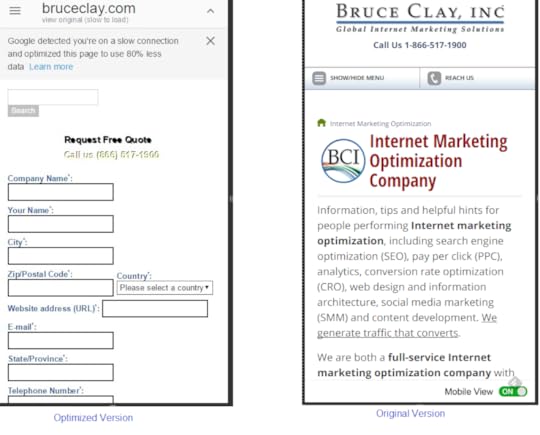Google Wants You to Make Your Site Faster or They’ll Do It For You. Will You Like the Result?
Google Wants You to Make Your Site Faster or They’ll Do It For You. Will You Like the Result? was originally published on BruceClay.com, home of expert search engine optimization tips.
In April, around the time of Google’s “Mobilegeddon” mobile ranking update, the search engine announced another mobile optimization in testing. Via the Webmaster Central Blog, Google said they’d “developed a way to optimize pages to be faster and lighter, while preserving most of the relevant content.” In other words, if you don’t optimize your site so that it loads quickly for mobile devices, Google will try to do it for you.
(Get your All-In-One Mobile SEO and Design Checklist here.)
Called transcoding, Google says it’s a feature intended to help deliver results quickly to searchers on slow mobile connections. Google’s early tests show that transcoding returns pages with 80 percent fewer bytes and 50 percent faster load times. Indonesia has been the staging ground for early field tests, displaying transcoded sites when a mobile searcher is on a slow connection, like 2G.
Sounds cool, right? Now website owners and SEOs don’t need to worry about optimizing sites to be fast; Google is going to do it for us! What a magnanimous thing for Google to do. Except that there are a couple of reasons why Google’s low bandwidth transcoder should give developers and webmasters pause.
The Cons of Transcoding
Google says the optimized versions preserve “most of the relevant content.” There are two editorial decisions in that phrase: most and relevant. The biggest problem here is that Google, not you, decides which of your content is relevant, and how much of it to show.
You probably didn’t hire a bot to design your website; do you want a bot optimizing it? Take, for example, the BruceClay.com home page, where it becomes evident that a lot of styling gets stripped out:

A page optimized by Google transcoding (left) next to the original version of the page (right). Click to enlarge.
The Pros of Transcoding
For each of the cons, some sites could see real benefits from Google’s transcoding:
For many websites owners, users’ seeing a stripped-down version of a site is better than not seeing it at all.
Google includes a link to the original page on the transcoded version, so users have the option to see the page how you built it.
Transcoded pages are undoubtedly fast. For a detailed comparison, I ran the two pages above through GTMetrix and came up with the following results:
Page Load Time
Total Page Size
Total Requests
Original Version
3.71 seconds
1.94 MB
155
Transcoded Page
0.56 seconds
17.3 KB
2
Viewing Your Transcoded Page
If you’re curious to see how your site renders when it’s been transcoded by Google, there’s a tool to show you just that. You’ll need to do a little workaround if you’re outside of Indonesia:
Using the Chrome browser, go to the Low Bandwidth Transcoder emulator at https://www.google.com/webmasters/tools/transcoder.
Click the toggle menu in the top right corner of the browser window, then click More tools and then Developer tools.
Along the top of the window you’ll see two drop-down menus: Device and Network. Select any smartphone device from the menu selection, like the Google Nexus 4.
Enter the URL you want to test in the “Your website” field and click the Preview button.
Click the URL that appears below the text “Transcoded page:” and you will see how the page renders as Google transcodes it.
When Will We See Transcoding in the Wild?
A lot of this has to do with being lightweight; it’s not enough to use CDNs or have a high-end server. Google cares about the experience of people who access the web at the narrow end of a bottleneck, which is completely out of the hands of web developers. Your fast server only means so much to users on a 2G network.
At this point, we have no idea when, if at all, this functionality will be implemented anywhere outside of Indonesia. However, Google’s underlying statement is clear: websites should be really, really fast.
For information on how to optimize your pages for speed and mobile SEO, we recommend starting with these resources:
The All-In-One Mobile SEO & Design Checklist
SEO Tutorial: Mobile SEO and UX Optimization
Image Optimization: The #1 Thing You Can Do to Improve Mobile UX
Webmaster’s Mobile Guide by Google Developers




